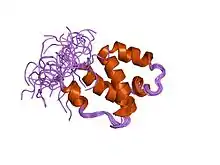SWAP protein domain
In molecular biology, the protein domain SWAP is derived from the term Suppressor-of-White-APricot, a splicing regulator from the model organism Drosophila melanogaster. The protein domain is found in regulators that control splicing. It is found in splicing regulatory proteins.[1] When a gene is expressed the DNA must be transcribed into messenger RNA (mRNA). However, it sometimes contains intervening or interrupting sequences named introns. mRNA splicing helps to remove these sequences, leaving a more favourable sequence. mRNA splicing is an essential event in the post-transcriptional modification process of gene expression.[2] SWAP helps to control this process in all cells except gametes.
| Surp | |||||||||
|---|---|---|---|---|---|---|---|---|---|
 Solution structure of SURP domain in BAB30904. | |||||||||
| Identifiers | |||||||||
| Symbol | Surp | ||||||||
| Pfam | PF01805 | ||||||||
| InterPro | IPR000061 | ||||||||
| |||||||||
Function
The role of the protein domain SWAP is to control sex-independent pre-mRNA processing in somatic cells, that is, in every cell except the sex cells This includes autoregulation, whereby it regulates the splicing of its own pre-mRNA.[3] The mammalian homologue of SWAP acts as a thyroid hormone regulated gene. This mean it is controlled by the thyroid.[4][5]
Structure
SWAP proteins share a colinearly arrayed series of novel sequence motifs.[3] This means that they have been conserved over time. The SWAP protein in different organisms share some similarity in terms of sequence and may have been related at some point in evolutionary history.
References
- Denhez F, Lafyatis R (June 1994). "Conservation of regulated alternative splicing and identification of functional domains in vertebrate homologs to the Drosophila splicing regulator, suppressor-of-white-apricot". The Journal of Biological Chemistry. 269 (23): 16170–9. PMID 8206918.
- Clancy, Suzanne (2008). "RNA Splicing: Introns, Exons and Spliceosome". Nature Education. 1 (1). Retrieved 31 March 2011.
- Spikes DA, Kramer J, Bingham PM, Van Doren K (October 1994). "SWAP pre-mRNA splicing regulators are a novel, ancient protein family sharing a highly conserved sequence motif with the prp21 family of constitutive splicing proteins". Nucleic Acids Research. 22 (21): 4510–9. doi:10.1093/nar/22.21.4510. PMC 308487. PMID 7971282.
- Cuadrado A, Bernal J, Muñoz A (August 1999). "Identification of the mammalian homolog of the splicing regulator Suppressor-of-white-apricot as a thyroid hormone regulated gene". Brain Research. Molecular Brain Research. 71 (2): 332–40. doi:10.1016/s0169-328x(99)00212-0. PMID 10521587.
- Khan A, Sulkowski ZL, Chen T, Zavacki AM, Sajdel-Sulkowska EM (June 2012). "Sex-dependent changes in cerebellar thyroid hormone-dependent gene expression following perinatal exposure to thimerosal in rats". Journal of Physiology and Pharmacology. 63 (3): 277–83. PMID 22791642.